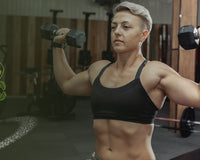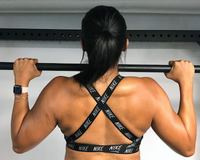 The Zercher Squat
The Zercher Squat
Due to the unique positioning of the barbell, the Zercher squat is one of the most interesting variations of the traditional barbell squat. While this exercise may seem a bit unorthodox, it is one of the best full body exercises you can perform with a barbell.
As you become more comfortable with the Zercher squat, it will be one of your favorite exercises in no time.
Muscles Worked by the Zercher Squat
Primary Muscle Groups:
Like other squats, the Zercher squat is a compound exercise that works lower body muscles such as the quadriceps and the glutes. Four muscles comprise the quadriceps: the rectus femoris, vastus intermedius, vastus medialis, and the vastus lateralis.
While the barbell Zercher squat works all four of these muscles, it is specifically one of the best rectus femoris exercises.

In addition, any squatting motion inherently engages the glutes. Comprised of the gluteus maximus, the gluteus medius, and the gluteus minimus, the gluteal muscles contract the most at the bottom of the squat.
That being said, this exercise most effectively targets the gluteus maximus, the largest of the three muscles.

However, the Zercher squat is not solely a lower body exercise. The unique positioning of the barbell forces an upright posture which engages the back as well. Other primary muscles include the lats and the erector spinae.
The latissimus dorsi is a broad, flat muscle that spans from the spine outwards and aids in the adduction of the arm. The erector spinae is a group of three muscles known as the spinalis, longissimus, and iliocostalis.
These muscles help our spine bend in various directions. The Zercher squat is a fantastic exercise to train these important back muscles.

Secondary Muscle Groups:
In addition, the Zercher squat secondarily engages the biceps and the core. Because the barbell rests in the crook of the elbows, this tension produces an isometric contraction of the biceps. In other words, the biceps receive significan tension while remaining static.
Core muscles are also very important in this motion. The weight is distributed in front of the body which forces the core muscles to contract and stabilize even more than they would during a traditional squat.
Zercher Squat Benefits
1. Strength Gains
Clearly, there are a myriad of muscles worked by the Zercher Squat throughout the body. Even though you may not be able to load as much weight as you would for a traditional squat, this exercise will absolutely make you stronger.
It may not be performed in Olympic weightlifting competitions, but the Zercher squat is bound to improve your lower and upper body strength.
Whether you are a professional weightlifter or a casual weightlifter, taking the time to learn this exercise will help you become a stronger, sturdier individual.
2. Minimal Stress on the Spine
Traditional back squats place a heavy load on the spine. This can be dangerous for heavy lifters or for those who have back problems. Thankfully, the Zercher squat removes much of the tension placed on the spine.
Just make sure to start light and work your way up to ensure optimal form for strength and safety!
3. Improved Core Stability
The Zercher squat activates nearly all of the core muscles during the squatting motion. Because the barbell is placed so close to the midsection, the core is partly responsible for keeping the barbell in place.
Greater core stability translates to improved performance in nearly every other exercise, especially compound motions such as deadlifts or traditional squats.
How to do the Zercher Squat
Equipment:
To perform the Zercher squat, you need access to a barbell and a squat rack. You also may find the positioning of the barbell to be uncomfortable on your elbows or biceps.
Don’t listen to what they tell you — there is no shame in using a foam barbell pad for this exercise. If you don’t have access to a foam pad, try wearing long sleeves.
Setup:
a) Set up the barbell at roughly belly button height.
b) Stand at the same width you normally would for a traditional squat.
c) Place the barbell in the crooks of your elbows. You can grasp your hands together if it helps you stabilize the barbell.
Action:
a) While maintaining an upright torso position, squat downwards. You should be able to achieve greater hip depth with the Zercher squat.
b) Next, drive upwards with your quads in a controlled manner.
c) Maintain tightness and repeat!

Recommendation:
This exercise can be difficult at first. Start with very little weight — as you become more comfortable, you can start stacking on the plates. The Zercher squat is a great supplementary exercise for people of all skill levels.
To start, aim for 3 sets of 8-12 reps. If your elbows aren’t bothered by the weight, add on some weights and do 3 sets of 4-6 reps.
Common Zercher Squat Mistakes
1. Leaning forward
At the bottom of the squat, many people have the tendency to allow the weight of the barbell to pull their weight forward. This will compromise the efficiency of the exercise and potentially your own safety.
Keep your core and your biceps tight to ensure that your weight is centered during the lift.
2. Raising your hips too fast
When learning how to do a squat, some people will “bounce” upwards at the bottom of each rep. Avoid this when doing the Zercher squat. Bouncing at the bottom will place too much stress on the elbow tendons and could compromise your form.
Instead, focus on controlling the motion and mastering the form to see the full benefits of the Zercher Squat.
Zercher Squat Variations
1. Zercher Squat with Chains
Adding chains to either end of the barbell is a great way of adding accommodating resistance to the Zercher squat. This adds more tension to the upper portion of the workout and decreases tension at the bottom of the squat, where the most energy is required to burst upwards.

2. Zercher Lunge
The Zercher style of holding the barbell can be applied to other compound exercises as well, including the lunge split squat. In this variation, grasp the bar Zercher style and focus on performing each lunge in a slow, controlled manner. The Zercher lunge split squat is a great test of your balance and control.

3. Zercher Bulgarian Split Squat
The Zercher Bulgarian squat is a perfect variation for those looking to increase hypertrophy in their glutes. As with the Zercher lunge, the Bulgarian squat demands a high level of balance.
This variation trains your biceps and your glutes simultaneously, which gives it an added bonus over the traditional Bulgarian squat.

Zercher Squat Alternatives
If you enjoyed the Zercher squat, check out these other leg, glute, and back exercises to improve your total body training:
1. Goblet Squat
Setup:
a) Begin by holding a dumbbell vertically with both hands securely under the top part of the weight.
b) Assume a standing position with your feet roughly shoulder width apart. Engage your core and keep your back straight.
Action:
a) Hinge at the waist, bend your knees and lower your hips towards the floor.
b) When your hips are in line with your knees, pause for a moment and contract your quads and glutes to drive up to the starting position.
c) Repeat this motion for your desired number of reps.

2. Barbell Reverse Lunge
Setup:
a) Load some weights onto your barbell and place it securely on your rear deltoids.
b) Start from a standing position with your feet roughly hip width apart, your chest held high, and your back straight.
Action:
a) With your left foot straight in front of you, step back with your right foot and lunge down until your right knee touches the ground. In this position, your left knee should be directly over your left ankle.
b) Next, drive upwards in a controlled fashion to the standing position.
c) Repeat this motion for your desired number of reps. Feel free to alternate legs or complete one side at a time.

3. RFE Split Squat
Setup:
a) Begin by placing your trail foot on the elevated surface behind you.
b) Step outwards with your lead foot so that your trail leg is slightly bent.
Action:
a) Lean slightly forward and keep your back straight.
b) Engage your core and squat downwards into your front leg.
c) Pause for a moment at the bottom of the rep and drive upwards with your lead leg.
d) Maintain tightness in your core and repeat!

Looking for a Full Leg Workout?
Check out this intense 5-minute at home quad workout!
Join the Invasion!
This Anabolic Aliens membership will grant you access to workout classes, rehab programs, diet plans, and more exclusive content to help you achieve sustainable success!










